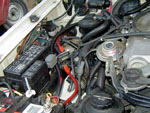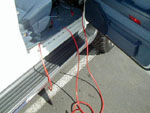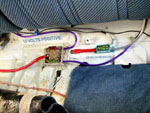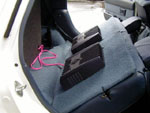

Optimizing Audio Wiring
Author: Corey
Tando November, 2000
 |
| The Phoenix Gold power lead is run directly off the battery to a circuit breaker. |
When it came time to upgrade my 4Runner's stereo system, I had no idea how to do it. I knew what I wanted for equipment after doing research and shopping around, but I knew nothing about the hidden stuff such as the wiring - which is just as important to a properly tuned system as the individual components are. So, off to the internet I went in search of more info.
I had an older system in my 4Runner that was adequate, but the system did not provide any bass nor did it have an amplifier to truly make it shine. So I began upgrading the system, which included adding a Sony M650 head unit, a 15" subwoofer in the rear of the SUV, and upgraded door speakers. While the system provided improved performance, it still did not seem properly tuned: a well-engineered system allows the listener to play music at high volumes without the distortion common among factory setups or underpowered aftermarket setups.
When my first amp was
installed, I used 12 gauge wire from the battery back to the amp. This
is acceptable for a one amp system that is not too powerful, but 10 gauge
would have been better to handle the increased load. The bigger the wire
(within reason), the more power can get back to feed your amplifiers so
they won't be starving for voltage, thus increasing the wattage and sound
quality that finally reaches your speakers.
 |
| The Phoenix Gold 4 gauge power lead and circuit breaker powers and protects the amp. |
So I took a good look
at my system and after doing more research, I found out the power wire
could be the weakest link, particularly for bass notes to sound real tight.
I knew I would be adding another amp in the future, but I wanted my setup
to sound better than it did. After gathering more recommendations, I went
with Phoenix Gold High Energy Core Power Flow 4 gauge wire, which features
a 105 degree (Celsius) oil and gas-resistant jacket, along with electrolytic
Grade 30 copper stranding to draw maximum current transfer.
 |
| When working with the heavy gauge wire, sometimes pliers and a light tap with a hammer are required to get a good crimp. |
You can get bigger wire
such as 2 or 0 gauge, but 4 gauge is more than adequate for the 1000 watts
I'm pushing from my two amps. 2 or 0 gauge would be preferred for super
high wattage amps running several subs.
 |
| Wiring the main power lead back to the distribution block. |
For a two amp setup like
I have, you should have at least a 100 amp fuse about 18" from your battery,
and then the rest of the 4 gauge can lead back to a distribution block
that allows 4 gauge in, and 8 gauge out. I chose to go with a 100 amp circuit
breaker instead of a fuse for a few reasons: if my system ever trips the
breaker, it's much easier to just hit the reset on the circuit breaker
instead of pulling a fuse and putting a new one in. Also, when I drop my
vehicle off to get some work done, I don't have to worry about the attendant
testing to see how much bass my sub woofer can take - I just push the button
on the circuit breaker, and my amps won't be powered.
 |
| The distribution block. |
For the distribution block
I mentioned, I used one with 3X4 gauge leading in, and 4X8 gauge leading
out. You can get a distribution block fused or unfused, but the fused type
is recommended for the added protection it offers. Even though you have
a fuse or circuit breaker up by the battery, if an amplifier decides to
blow up on you, with a fused distribution block close to the amp, there
is less chance of a fire happening by a hot wire. Each line output from
the distribution block leading to an amp should be fused. I elected to
use the blade type fuse over other fuses, but they all serve the same purpose.
I am also using an unfused
1X4 gauge in, and 2X8 gauge out distribution block for my two ground wires
that come from the amp. It's a good idea to use the same gauge for your
ground as you do for your power wire, since the ground completes half of
your circuit. In my case, since I'm running 4 gauge to the distribution
block, and then 8 gauge to each amp, I have the ground setup in the same
exact manner.
 |
| Mounted amps with 12 gauge to the sub. |
For the speakers, 16 to 18 gauge is more than adequate. But for the wire that goes from the output of my bass amp to the subwoofer itself, I am running bigger 12 gauge so I don't starve the sub.
The main purpose of this article is to make sure you build your system properly the first time - and consider the wiring as important as the components for an optimized system. I found doing it myself very easy, rewarding, and best of all, knowing that it's now done right. Expect to pay a little more for the bigger wire, as well as the circuit breaker if you get one instead of an inline fuse. But with the bigger wire, you will be reassuring yourself of cleaner, tighter, and better sounding tunes down the road or trail.
If you choose to do this good luck, and
if you have any questions ![]() (Corey) on the Yotatech Forum.
(Corey) on the Yotatech Forum.
Back to YotaTech